In our last piece we went over more issues with public transit, looking at some real world numbers. It was fun, but it’s been too long since we made fun of a redditor, so let’s fix that.
This might not be a very popular take but I wish cars would be banned in all cities with populations exceeding 50,000 people. I’ll just come out and say it, I don’t really give a shit if people in rural areas are affected by that, and that is coming from someone who lives in a rural area. Nobody is forcing them to live out in the middle of fucking nowhere, and cities should not have to sacrifice walkability and overall livability for people who don’t even live there.
If I was in charge I would build a small business district on the outskirts of town, containing the essentials (hardware store, grocery store, hospital, government services etc.) that folks from rural areas can access, but anything beyond that can only be accessed via public transit, or by walking or biking into town.
Another incredibly intelligent redditor trying to re-engineer society.

I included a screenshot so that you could see this is indeed a real post.
First of all, Xir says that he wants a city that has nothing but public transit, walking, and biking. Once we have that then muh walkability achieved, don’t ask questions about crime. As could be predicted, the urbanites conveniently forget the wheeled fecal matter distributing monstrosities that cars actually replaced. But apparently we can just have bikes replace the horses. This seems practical.
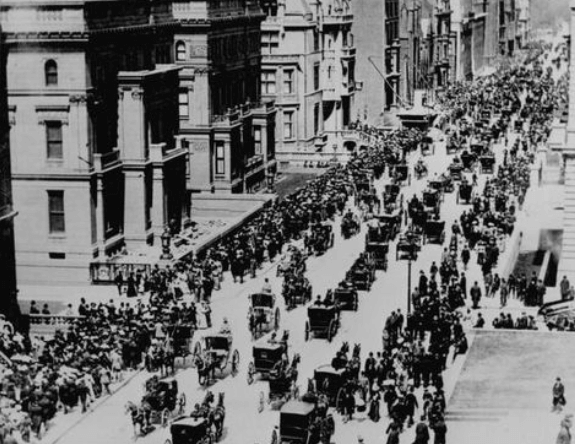
If user Rexberg-TheCommunist was put in charge cities with populations over 50,000 would get to enjoy starving to death, since trucks wouldn’t be able to bring the goods a city needs into town. But he does make sure that ruralites get access to a small business district on the outskirts of town with the essentials, as he sees fit. Then people from rural areas can go there, and leave the bugcreatures alone with their Nintendo Switches and mass starvation.

Mostly abandoned mining town.
Xir claims to be a ruralite xirself, but I doubt it, especially when he says that he doesn’t know why anyone would live in a rural area. After all, a lot of rural areas have very specific purposes, such as mining towns, or industrial plants. Unless we tear down some skyscrapers and start building farms in downtown Manhattan, there will necessarily be rural areas for the production of the essentials of life.
But enough of that. Today we argue that trains are broadly speaking used for exactly what they should be used for in North America, which is subways and light rail in cities, and freight from very large industrial/agricultural sites to destinations such as ports.
In the above video Wendover Productions starts off by whining about the decline of passenger rail, as if this was some catastrophe. As I’ve stated before, this is exactly what we’d expect the new technologies of automobiles and planes to do to passenger rail, since planes are an order of magnitude faster, and automobiles do personalized service.

That’s a lot of land to be gifted.
Additionally, railways were enormously subsidized by the federal government, so lolbertarian-tier crackpot theories about trains declining because streetcar systems in Los Angeles were holocausted by evil car manufacturers don’t make much sense. The same goes for This One Weird Law that he’ll get to later in the video.
(Starting around 4 minutes)
With the arrival of the combustion engine [satisfying capitalists and the public] became impossible. The reason behind American Rail’s decline are well established. Affordable automobiles, improving roads and highways, and increasing consumerism sent passenger rails plummeting.
He includes this graph, which may be fake, but seems plausible. It shows the WW2 rationing spike, followed by the steady decline as passenger rail was outcompeted by airplanes and automobiles. He doesn’t mention planes one time in the entire video, which is laughable. Also, I don’t know what “increasing consumerism,” means.
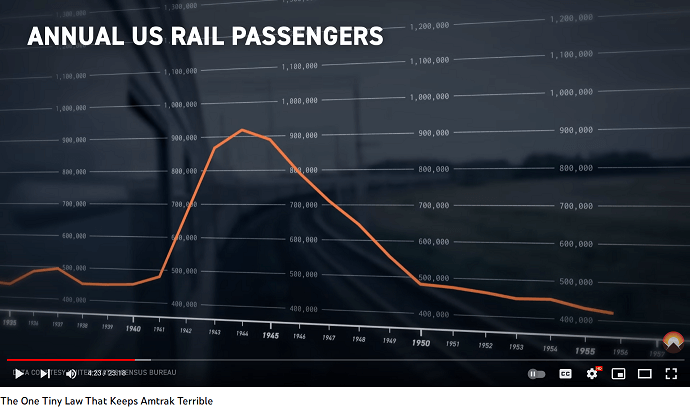
The premise that this is bad is simply snuck in there. I could do the same thing with the horses. Automobiles holocausted their utility to society, so cars must be banned, with the premise being that people must be riding horses for some reason. As is often the case, vague and unquantified notions of “wealth building,” are thrown out as justifications.
Then, during World War II (1941-1945, when there was gasoline and tire rationing), rail travel surged to record amounts, peaking at nearly 98 billion passenger-miles in 1944. After that, steady decline in rail travel set in as Americans took to the highways and, increasingly after 1960, to the skies. By 2000, rail passenger-miles, for commuter and intercity, were about 15 billion. But the U.S. population was much greater, and overall mobility had expanded enormously since mid-century. (Sources: U.S. Department of Transportation; Eno Foundation; Assoc. of Western Railways, Railroad Facts, 1958 ed.)
I decided to look up the actual numbers, and it turns out that passenger rail has been on its way out for a century. This process got interrupted due to extreme rationing of rubber and gasoline during WW2, which makes it seem like peak passenger rail was more recent than it ought to have been. Post WW2 the decline resumed again with a vengeance.

Again, passenger rail makes sense for subway systems, the occasional tourist line, or high speed rail in areas that have extreme population densities, like the Beijing-Shanghai line in China. We have planes and automobiles. If you’re going to subsidize anything, it makes sense to subsidize planes.
But I’m getting ahead of myself. We’ve got a video to transcribe.
And it wasn’t just cars making things worse for the rails, but trucks. Freight now faced its first real competition after WW2 as American trucking companies operated on interstates moving increasingly diverse goods from increasingly dispersed factories to various, alternating locations.
I think that these urbanites have a contract that they all signed, where they are not allowed to mention at least one elephant in the room per video. That’s often the existence of horses, or massive historical subsidies for rail. This guy chose to steadfastly avoid talking about airplanes, which is really bizarre in a video about passenger rail.
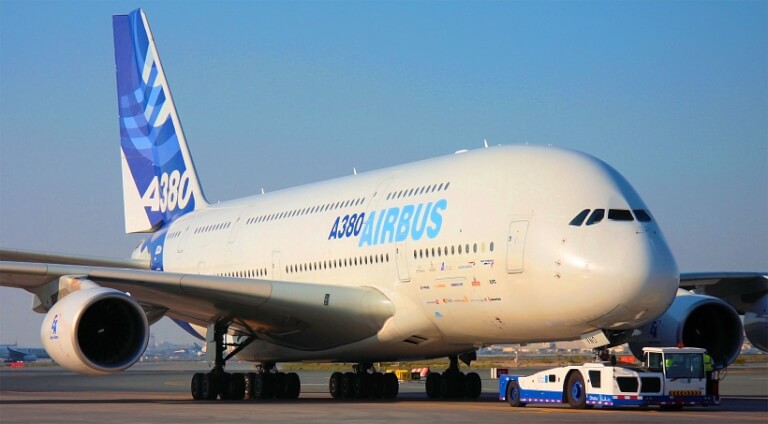
Pictured: Pedal powered passenger rail bashing machine.
Nevertheless he at least acknowledges that the flexibility of trucks, and their ability to take irregularly sized loads from dispersed locations to dispersed destinations at irregular time intervals, which puts him head and shoulders about the rest of the crowd. It’s nice to hear one of these guys not pull out the “rail is more space efficient” non-sequitur.
In a 1967 Government report, officials concluded that for every dollar a carrier would lose if discontinuing a passenger service, it would save between $1.45 and $2.42 in costs. But the rails didn’t run these routes because they turned a profit. They ran them because they had to. The interstate commerce commission, established to ensure the rails continued to provide service to the American consumer, in this case by maintaining important travel corridors, made it practically impossible for railroads to abandon passenger routes, no matter how deeply unprofitable.
By the late 1960s the rail industry was on the verge of collapse. With a vitally important cog to the American economy on the brink, the federal government decided to step in.
How are empty passenger trains vitally important to the American Economy?

I could say that passenger horses are a vitally important cog to the American Economy, therefore we must subsidize them at all costs, but that would be stupid. Even this video admits that passenger rail was simply being holocausted by superior transportation service provided by automobiles and planes. So if we must have passenger rail, why not also horses everywhere?
Anyway, he then gets into a bit of complicated legality that ends up, in practice, with freight rail being given priority over passenger rail. Apparently this is the reason why Amtrak sucks. It’s definitely not because American is freakin’ enormous and sparsely populated, making flying a vastly more attractive option for most people.
Above is a video by a guy who spent 66 hours on a Chicago to Texas to Los Angeles train trip. Sixty six ****ing hours. Do I even need to tell you that a flight between those two locations takes four hours.
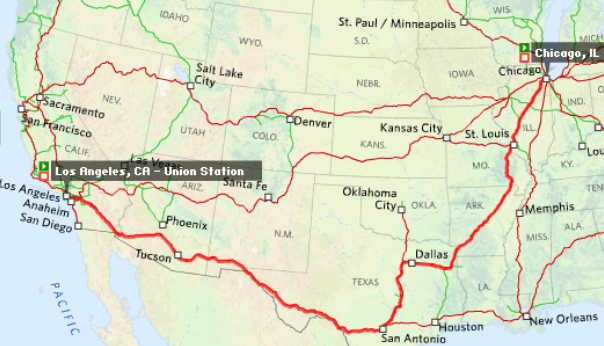
The red bolded line was the route he took. Four days, three nights. You can drive there in 27 hours, call it thirty, stopping whenever you feel like on your journey, making this doable in two days, and comfortable in three. And at the end, you have your car with you.
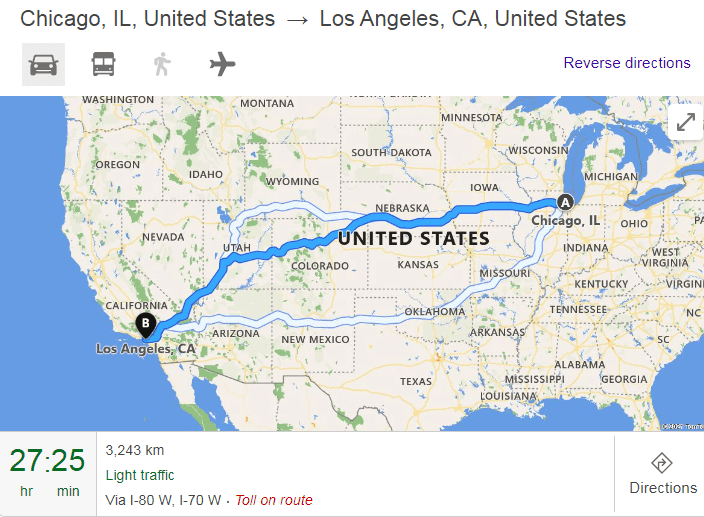
When flying you don’t get to have your car at the end of your trip, and it takes 4 hours, maybe 6 when you factor in driving to the airport, going through security, and picking up your luggage. If you drive, it takes you three days of driving, but you stop whenever and wherever you feel like, and you get to have your car at the end. If you take the train it takes you four days and then you arrive with your legs at a station full of Crime-Americans and used needles.

Unsurprisingly, the train is half empty.
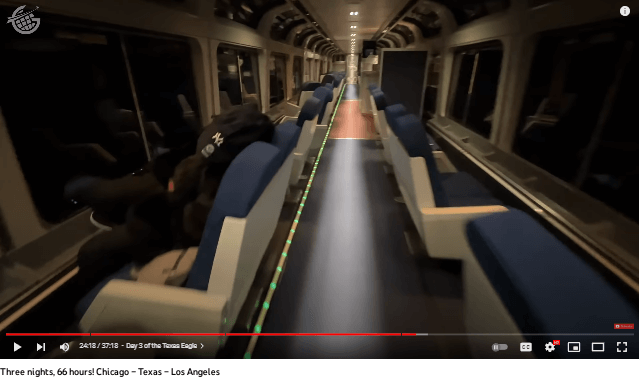
At first I thought the guy was just respecting everyone’s privacy, but no, it’s a half empty train.
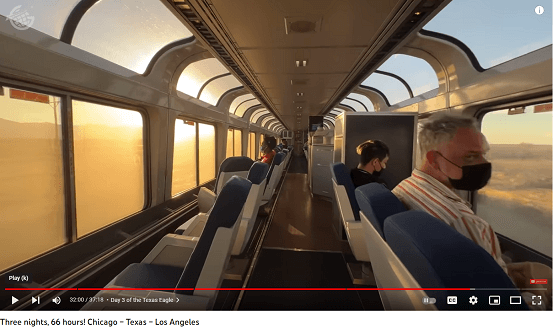
I wonder why.
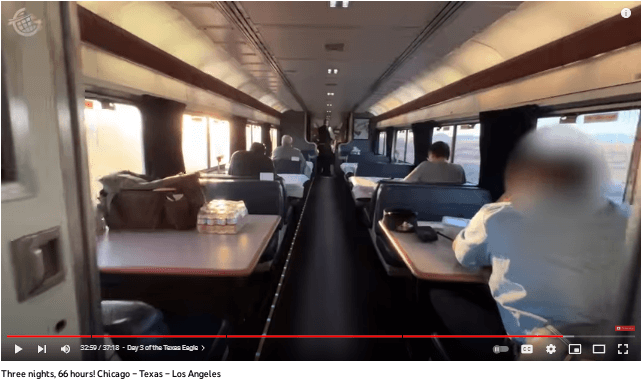
For the record, there is nothing wrong with wanting to ride the train as a personal choice. There are definitely some benefits, such as the romance and comfort of rail travel. But riding horses is romantic as well, and there are plenty of other transportation solutions that can improve on America/Canada as is. Liking trains is fine. Having a train fetish is not.
Now back to Wendover Productions.
While on the surface freight rail might look like a natural evolution of its predecessors from a century ago, down below the industry has reinvented itself, as it’s become fixated on a series of seemingly practical, but actually misguided operational metrics that have lead its management down the path to constructing the weakest, least competitive form of freight rail in American History.
Least competitive? Weakest? Interesting way to describe an industry seeing record profits.
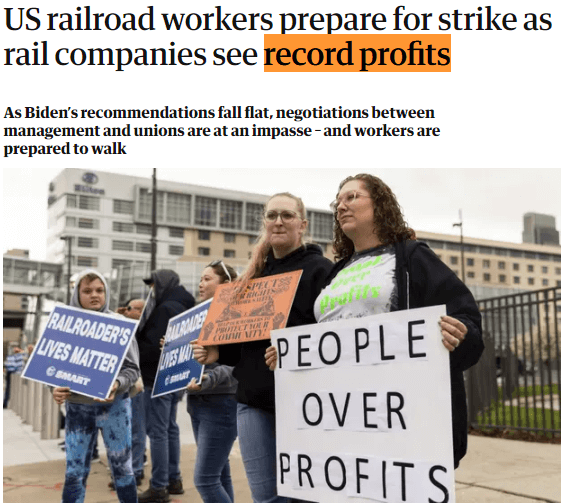
Yes, railroad corporations should be nationalized. These cunts refused to give rail workers one single sick day, and then Lunchpail Joe stepped in to give them one of the most one-sided deals that I’ve ever seen, not even giving the rail workers salary increases that keep pace with inflation. Even if they weren’t cunts they should still be nationalized, since infrastructure projects the size of railroads simply cannot be done without government intervention anyway.
But just because they care purely about profit and enjoy squeezing every last dime out of their own workers pockets doesn’t mean that we have to accept some random transportation fetish for passenger rail everywhere. Yes, the major rail corporations care purely about profit, and part of that is them doing things that actually make sense, like dropping passenger rail in favour of enormous and predictable freight hauls. Then they drop boutique freight service, leaving that to trucking companies, because they can’t compete against trucks for those jobs.
And they’ve taken passenger rail down with them.
Again, they’re literally seeing record profits.
For example, gross tonnage per train. The more freight carried per train, the better. Right?
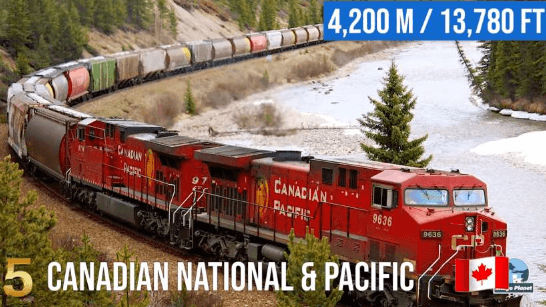
Yes. That’s why everyone runs the longest trains they can.
Well, longer trains are –

Stop. The answer was yes. I’m transcribing this because I have to, but prepare yourself for some annoying Well Ackshaully.
Well, [ackshually] longer trains are cheaper to operate. In fact, that’s perhaps the paramount factor in freight rail’s incredible cost effectiveness.
One can just keep adding and adding cars, and with each addition the average operating cost per unit of freight goes down as there are few additional marginal cost to adding additional weight and length.

This is the main advantage of trains. You can link huge amounts of cars together, literally miles long, and really exploit the advantages of fixed path infrastructure. Trucks can’t do this because they must share the road, and wouldn’t be able to turn anywhere.
Furthermore, since these trains are carrying freight instead of people, you can run them efficiently at lower speeds as the weight/drag increases, without people complaining that the ride is taking too long. And at low speeds the friction from the steel wheels of the additional cars is fairly low.
This is all true, in a vacuum.

“But ackshually I played Freight Rail Management Simulator, so I know better.”
To actually be able to increase their gross tonnage per train, companies had to simplify. With nearly boundless options of origins and destinations all across the nation it was simple math. They had to reduce the number of route permutations so that more traffic got aggregated into fewer routes.
To accomplish that, they took advantage of the newly deregulated business environment to negotiate massive volume deals and focus on simpler types of freight.

Literally all of that is good. It’s called exploiting the advantages of trains while minimizing the downsides. You simply can’t compete against trucking if you have small loads and tons of varying routes. It just doesn’t make sense. And by the way, this simplification is what public transit planners have to do as well, and it makes sense there all the same.
Through this operational simplicity the freight railroads were able to lower their rates far below what trucking could compete with. They’ve created a competition proof market segment, and this methodology could be replicated elsewhere.
He literally just said that this was the weakest, least competitive form of freight rail in US history. Now he admits that this model is so robust that it’s competition proof.

Freight rail does lots of work doing things like transporting goods from shipping ports like Vancouver to the downtown areas of cities like Montreal, or transferring enormous quantities of coal from mines directly to shipping ports. He whines about this, despite it being exactly what an intelligent society would do. It’s how I would use trains if I had to create a command economy, because that’s what trains are good at.

Trains flat out cannot compete with trucks when it comes to flexible freight. For distributed goods they always suffer from the Partial Trip Problem, so they need huge quantities of freight to be moved from a starting location to an end location that is fairly close to the actual start and end locations for those goods. That is why shipping coal from a mine to a shipping port is so reasonable. Since a semi-truck would do the exact same trip, there is little to no advantage. But tractor-trailers don’t usually follow the exact routes that trains take.
In contrast, here’s an example of the kind of trip that I would actually do as a long haul trucker.
- Take empty tractor-trailer from Langley, BC, to produce farm in Delta, BC. Load eight pallets.
- Go across the border to potato farm in Wenatchee, Washington. Load fourteen pallets.
- Go down to Olympia Washington, unload all the potato pallets.
- Go to Portland, Oregon and fill up with 10 pallets of flour.
- Drive to Los Angeles, California and unload the flour pallets at Warehouse in Compton (which is surprisingly nice these days).
- Drive across town to Warehouse2 in San Bernardino, and unload the produce pallets.
- Wait one day at a Love’s Truck Stop in LA.
This leg of the journey looks something like this. Every large circle represents a stop where some amount of goods are loaded or unloaded, aside from Langley and the truck stop in LA, which are the start and end points.
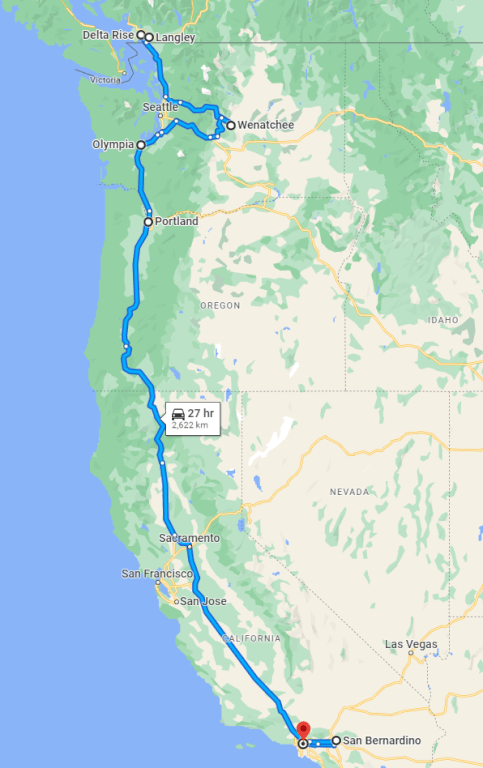
Below we have the trip back.
- Hit up Warehouse3 for 4 pallets of cherries Ranchita, CA.
- Go to Warehouse4 to pick up 6 pallets of random produce in Rancho Dominguez, CA.
- Go to an orange farm in Bakersville, California, to fill up with 10 more pallets. (Those places smell amazing BTW)
- Go to Warehouse5 in San Francisco for the last four pallets.
- Drive back to the lot in Langley, BC and drop the trailer.
Here is roughly what that trip would look like.
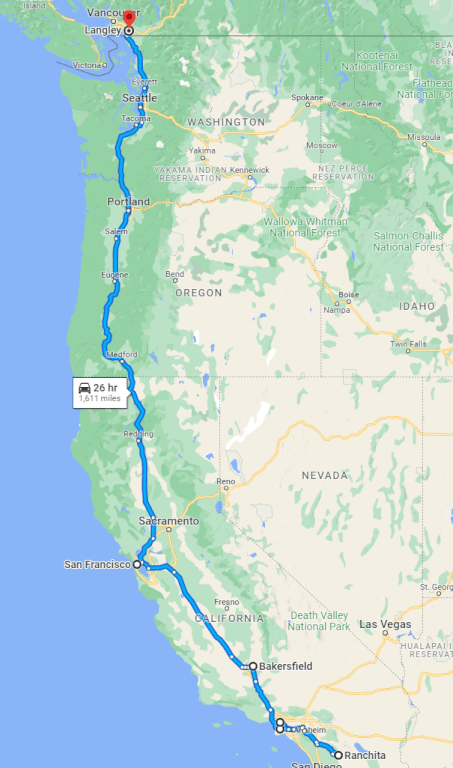
And this view is simplified, since we’re not hitting the cities, we’re hitting very specific warehouses inside of these cities. We also dropped the trailer at HQ, but the journey for the goods inside it is far from over. They now need to be delivered to very specific locations in the Lower Mainland. I say all of this so that you understand in no uncertain terms, rail cannot compete with this type of freight.
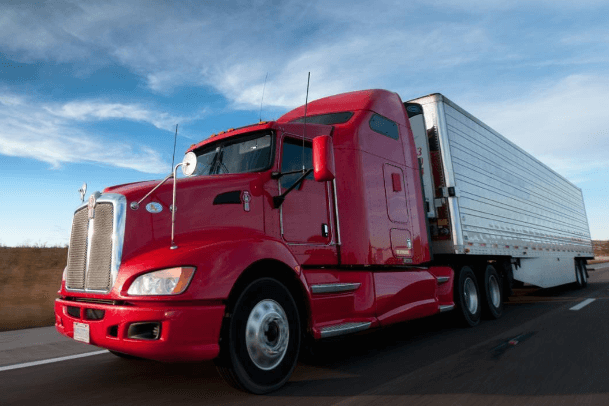
If you wanted to do this by train you would need to have a bunch of 5 ton trucks aggregating the goods from the warehouses and bringing them down to a train station, in either Vancouver or LA depending on which leg we’re talking about. Then the train makes the journey, and for some reason stops in downtown Seattle just so a few pallets can be taken off and shipped out to Wenatchee, Washington. Then the train pulls out again and stops in Portland. Another few pallets are taken off, and so on and so forth. This would take longer, require more trucks, and ruin any efficiency advantage of the train itself.
If, instead, you only stopped at LA and Vancouver then you simply wouldn’t be able to practically service Portland, San Francisco, Wenatchee, or Olympia. You could maybe hit the warehouses in Bakersfield, Rancho Dominguez, and San Bernardino, but would require 5 ton trucks picking the pallets up from the downtown LA train station and heading out to their end destinations, when you could have just had a semi-truck take the goods straight there.
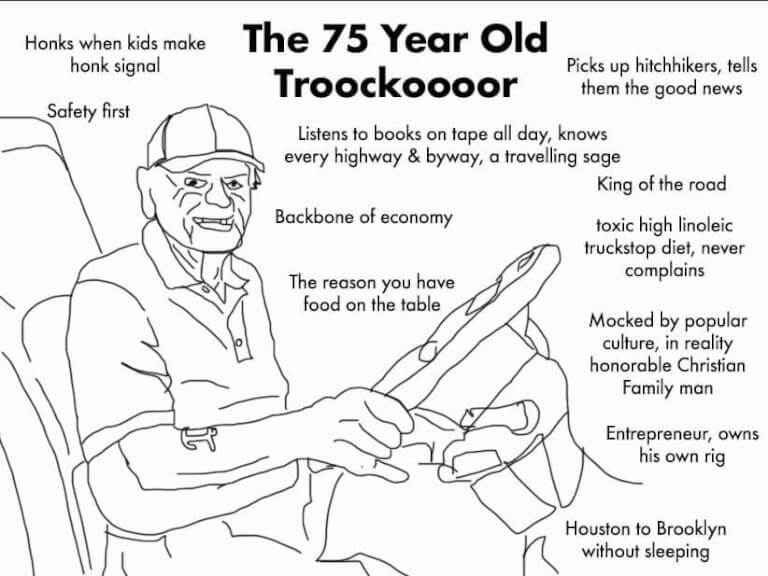
Now sure, occasionally I would pick up a full load from a warehouse, typically from Rogers Flour Mill and Production Facility in Chilliwack, BC. More rarely but still on occasion I would pick up a full load from a specific warehouse in Los Angeles and bring it all the way back. In those cases rail is more comparable.
But even in those cases, rail is still not competitive with trucking unless the amount of goods is enormous. If it’s one trailer amount, which is about 30k lbs, it will not justify the impracticality of trucking it to the local freight station, waiting for enough goods to be aggregated, shipping it, and then trucking it from the end station in LA/Vancouver to a distribution warehouse. Just use a truck and take it from point A to point B when it’s ready.

Part of the Rogers Flour complex, Chilliwack, BC.
I frequently went to Rogers Flour, pictured above, which had rail lines for the occasional massive movement of flour to one specific destination, such as the Port of Vancouver. They also had a massive truck loading bay. I couldn’t find a picture of theirs, but it looked like this, minus the European style trucks.

This is incredibly odd, since the Traffic Troons have assured me that trains are SUPERIOR to trucks because of some arbitrary definition of efficiency that does not include time, route, or payload flexibility. And yet, large corporations with rail access also go to the expense of building enormous truck loading bays. It’s almost like there are certain jobs that are perfect for trains, and others that require trucks. But it can’t be that. It must be that these corporations are run by cARbrAiNS and can’t imagine only using trains.

A wild hybrid appears.
I’ve said before that the Traffic Troons use simplified models to “prove” how superior public transit is to roads. They do the same to “prove” how superior trains are to trucks with their “space efficiency.” You can’t just simplify logistics to “goods go from City to City,” instead of tracing the complex path that trucks often take. If you simplify away the advantages of trucks, then sure, you want to use trains. If you simplify out the advantages of walking versus personal ICBM’s then you should always want to get around by intercontinental ballistic missile. Stupid models of reality give stupid conclusions.
It is very, very easy to make long term sacrifices to boost short term profit. Dismantling a line when it’s underperforming, even when that line might become useful again in the future, boosts short term profits at the expense of long term competitiveness against the trucking industry.

I can easily believe that rail corporations have made short term decisions to boost profits and stock prices. What I don’t believe is that you should keep unprofitable lines open because maybe, just maybe, they might make sense in the future. People like this are what give capitalism a good name, with their annoying shit tier analysis masquerading as fact. No, you shouldn’t keep unprofitable freight lines open just in case they stop being a massive waste of resources at some unspecified point in the future. Just let trucks outcompete them in the areas where trucks are superior, and focus on the areas where trucks can’t compete versus trains on price.
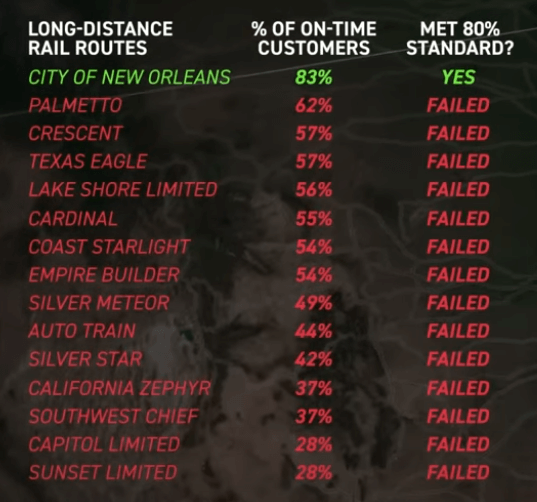
Wendover includes this list of Amtrak timeliness. About half of all the passenger trains don’t arrive on time, which he attributes to them having to wait for freight trains. This makes sense, but again, they share the track. Why are we just assuming that passenger rail should get priority over freight rail? What passenger rail can do is done by personal automobiles, buses, and airplanes, and is usually done better. What freight rail does is efficiently move massive quantities of goods necessary for industry. If we had a command economy run by geniuses we would probably have the same situation, just with a nationalized rail system.
Amtrak’s already timetabled it out. They think they can run service from Pueblo to Denver in 2:43. Then the stretch from Denver to Cheyenne would last 2:51. Each slightly longer than the 2 hour driving times, but not by much. Faced with traffic, parking fees, and loss of remote work productivity while driving plenty enough would elect to take the train to run 4 per day, according to Amtrak’s market analysis.

We’ll see in an upcoming piece that these guys love factoring in huge time costs to driving to the airport and getting through security. Then they turn around and just imagine that a car is starting from the train station and going to the train station in the other city. This never happens.
Instead, someone’s car starts from their garage and goes to their specific destination. In contrast, the train cuck needs to somehow find a way to the train station, avoid the druggies and used needles while waiting for their train, ride to the other train station, and then figure out how to get to their actual destination. Comparing travel times without factoring this in is fundamentally dishonest.
Amtrak has already identified dozens of other imperfect steps across the nation.
He then includes this map of all the routes that would work if only evil freight rail, which should be nationalized in part because it is crucial for our industry, keeps holocausting the passenger rail time.
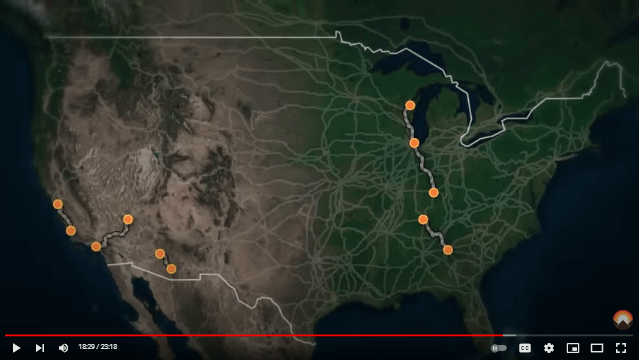
A casual glance at his map shows that little has changed. The vast majority of Americans would not notice the additional trains, although industry would be pretty fucked with the freight train delays and they might notice that.
Passenger rail is stupid in low population density areas. So stupid that even with moderate subsidies they can’t justify it in more than a few niche areas. This low density situation is the majority of America, and definitely the majority of Canada, even in the southern parts. What you should do instead is build a robust road system, as well as airports so people can just fly to destinations far away. But we can’t because GlOBaL wARmINg.
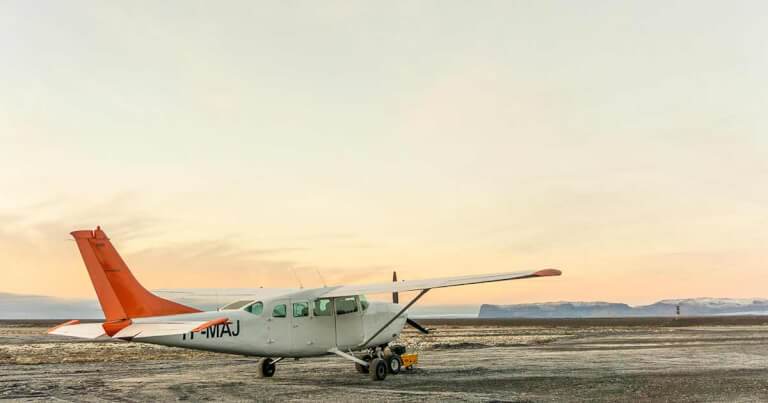
Although this type of plane flies at more like 300 kmph cruise speed.
Sometimes I wonder if we redefine planes as “flying high speed trains with 360 degrees of freedom that can go in straight line to the destinations,” if these dipshits would start supporting them. But then again, why have passenger airliners fly people at 900 kmph straight to their destination when you can build thousands of miles of winding rail tracks for high speed trains with top speeds of 250 kmph and average speeds far lower to go on that no one will ride because flying is so much faster.
Timeliness matters for passengers.

Pictured: airplane laughing at trains low speeds. 1844, colourized.
But the freight rail industry willingly and purposefully decided to cede the timely freight market. They decided it was too hard.

It’s not too hard, it’s literally impossible for them to compete against trucks on this front.
That trucking could have that business. And that they would focus on the slow stuff. Coal, and intermodal and others. So they’ve created a system of infrastructure where timeliness doesn’t matter.

Which makes sense, since that is what trains are good for.
Where they defer maintenance, let tracks go derelict, and impose speed restrictions. Where they fail to expand congested corridors, because the trains will get there when they get there.
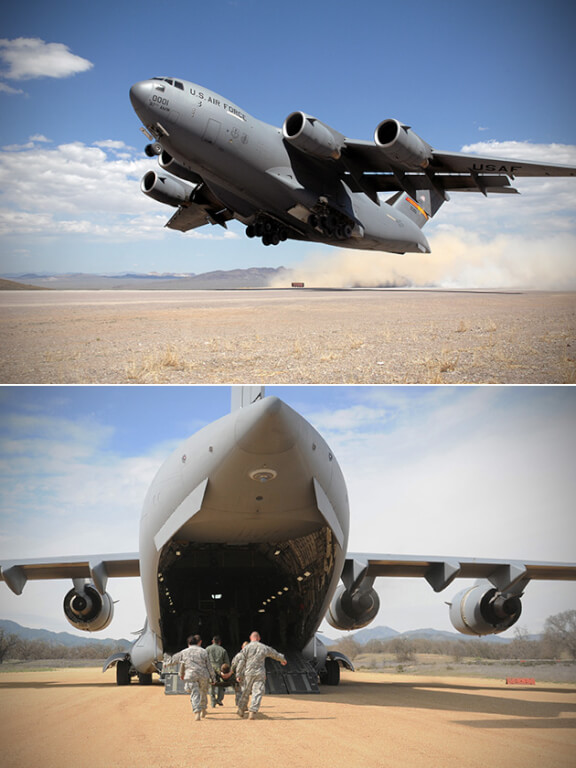
Almost like one of the major advantages of freight rail is that you can have a low average speed, since the people can just take passenger airliners and get there fast and the coal doesn’t mind waiting. It’s almost like you should lean into that advantage, and not try competing on speed against the things which are an order of magnitude faster than you. It’s almost like we don’t need One Weird Law to explain why passenger airliners have come to dominate passenger rail everywhere except for where there are extreme population densities, or massive government subsidies.
Increasingly freight rail and passenger rail in America are incompatible. But because of that bargain struck decades ago freight rail has the infrastructure, and passenger rail must use the infrastructure. So decisions are made time and time again that make it harder and harder to get back to that golden era.
He himself admitted that passenger rail was massively dwindling in popularity because people decided to drive or take planes. The entire rail industry was dying because they were legally forced to run passenger rail that they couldn’t possibly make even close to profitable. What golden era is he talking about?

Does he mean WW2 rationing, where everyone’s lives sucked because the military was hogging all the rubber and fuel so they had to ride passenger rail?

Get a load of this GoLDeN eRa.
The vast majority of Americans want a rail system like Europe, or China, or Japan. But that’s an incredibly difficult proposition to take on. According to most it’s one we should.
It’s not difficult, it’s impossible.
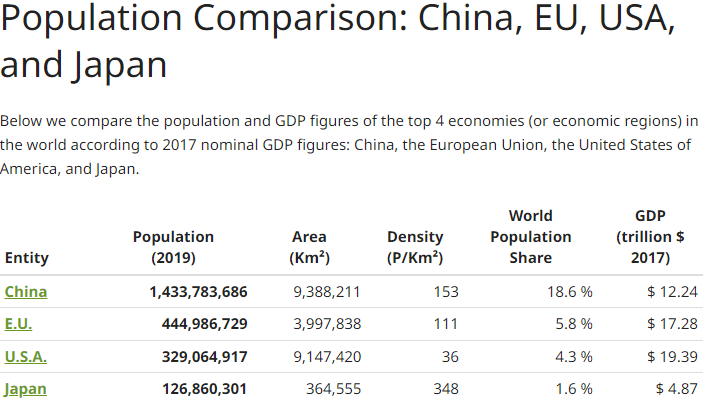
Japan has a population density of almost ten times America. China is effectively the same, since they have a very unpopulated deserted area. 
And Europe is dragged down by the 110 million Russians who live in the European part of Russia, and have a population density of 30, slightly less than the USA at 36. As a result, Russia has one single “high speed” rail line, from St. Petersberg to Moscow, a ~650 km line that has a theoretical max speed of 250 kmph, which barely qualifies as high speed rail.
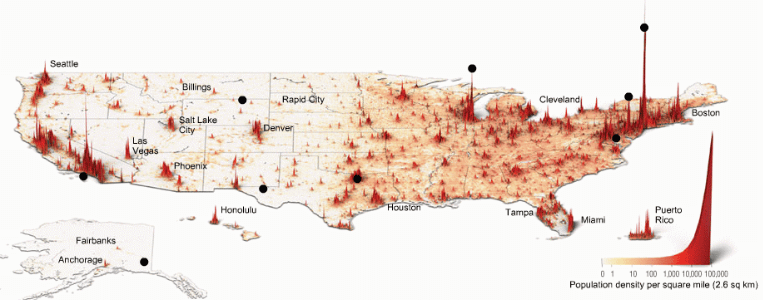
Rail lines have fixed costs per mile. So of course we should just slather them down willy nilly over depopulated areas of the USA. In fact, we should make that high speed rail so that it’s an order of magnitude more expensive, because train fetish. And we must never mention planes. Planes are the mind killer.

But technically you could build a high speed passenger rail network. Just like you could build a skyscraper in a random area of the USA. So it’s not impossible, just idiotic.
But to start, America can make that imperfect step. It can get just a little bit better before it gets great. It can use a little momentum to make it easier to get up to speed. But before anything the country and its legislature needs to recognize the inherent and increasing incompatibility in passenger and freight rail. The two industries are at odds, and for the benefit of both some sort of change needs to happen.

The only change that needs to happen is for rail to be nationalized. There is no compelling reason to have cross country railways do anything other than freight, barring some niche uses in high population areas like the Acela corridor. Hurting freight with delays so that shitty passenger rail can be slightly less shitty is not reasonable. Pretending that freight rail, which is making record profits, is in desperate need of help, and the way we’re going to help it is by causing tons of delays, is so stupid as to be incoherent.
– so we can stop imagining and start experiencing again an America where you can just go anywhere.

You can already go anywhere by getting in your car. Then you can go even more anywhere by flying around in a STOL plane or helicopter.

So I’m not sure what he’s getting at. It would seem –
– by train.

Oh right, train fetish. Sorry, I forgot that we must build this one particular form of transportation, no matter how absurdly impractical and expensive it is. Expanding the highway system, ridiculous. That’s just caR InFRaSTruCTuRe, and therefore bad.
Building a bunch of airports everywhere? Utterly absurd. We can’t just fly over the empty areas of this country at 900 kmph in planes with no infrastructure laid down other than the airports. No, we absolutely must spend billions, trillions even, building high speed rail lines to nowhere because I get sexually aroused by choo choo noises.
You might remember how, back in late November, the US was facing the potential of a crippling freight rail strike. The contributing factors are pretty closely related to what this video is about. In an effort to cut costs management has consistently reduced average staffing per train, and implemented regressive working rules.

I wrote about that here. It’s nice to see this guy at least take the side of the workers. You know I can be too hard on these types, but I think they’re all genuine, decent –
Now, the way I stayed up to date and informed by this dispute, and the potentially catastrophic hit to the US economy that would have ensued if the Biden Administration hadn’t forced an agreement was through our sponsor, Morning Brew. Everyday I wake up to –

Nevermind. Thank Biden for preventing this catastrophic hit to muh economy by “forcing through” the shit sandwich that the rail corporations were offering. This is the kosher left we’re talking about. They’re done pretending to be anti-war, and the whole pro-worker stuff will only be brought up to oWn dA CoNS. Also, it doesn’t make sense to bring up the vital importance of freight rail to the US economy when the entire video is whining that freight rail gets priority over passenger rail, but what do I know?

Yes, we should have gigantic infrastructure projects in our country. No, these projects shouldn’t be high speed passenger rail. Even as far as transportation goes, building oil and fuel pipelines to run refineries to run small airports, STOLports even, makes a whole hell of a lot more sense than this random garbage. I know that there are a lot of people in our thing who think that it’s ridiculous that we don’t have high speed rail in this country. It’s not. It’s ridiculous that we don’t have more airports and oil pipelines running everywhere.
I’ll get to that in a later piece.


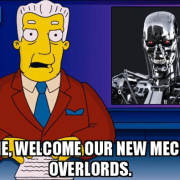


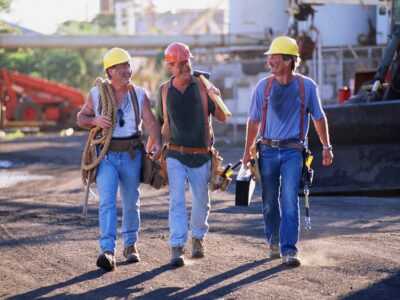








Sounds like the only future passenger rail could have had is finding a balance where the strengths of rail work with the strengths of automobiles like the freight rail industry figured out.
I live across the country from family, so to see them is a miserable three day drive, with children in a minivan or SUV. I would LOVE a system where I could instead drive the family to a railway hub, load ourselves into a passenger car and put our vehicle on a flat car, then have a train ride across country and unload in the railway hub nearest our family and finish with a drive. If these these loading hubs were built to be near major interstate intersections and NOT in cities it would be perfect.
That would undoubtedly be a great system. Having your car at the end of a trip while not having to drive is the dream. I do question how realistic such a proposition would be though.
I myself would like to see zeppelins make a comeback. Gracious, low-altitude, low-speed cruising. Waving at the plebs on the ground below. Drooping anchor, and docking at the top of downtown skyscrapers. Honestly, these train troons should reconsider their fetish, and instead argue feverishly for zeppelins.
Zeppelins can be great for quiet site seeing, at least theoretically. I doubt they have any valid purpose other than that, and they are enormous. But yeah, arguably the coolest form of transportation ever devised.
[…] PSA: Deboonking the Traffic Soyboys Part 16 – The Case for Using Trains Exactly how they’… […]